
Station Name: MIDDLETON TOWERS[Source: Glen Kilday]
Middleton Towers Station Gallery 1 c1900 - September 1968 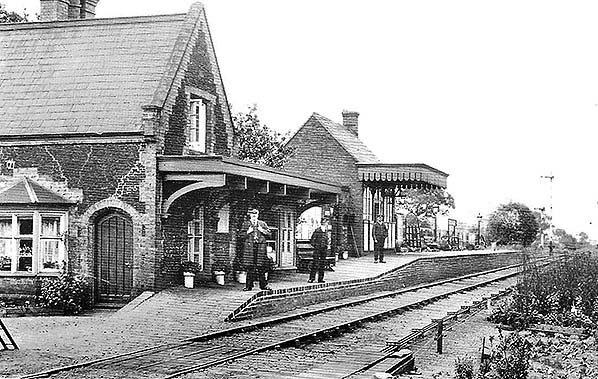 This image, undated but from about 1900, shows the station staff on the platform at a neat and tidy Middleton station. Kelly’s directory for Norfolk, 1904, lists William George Nunn as Station Master and it may be him nearest the camera. Of note is that the knapped flint walls on the station house, by then 50 years old, had been repaired.
Photo from John Mann collection  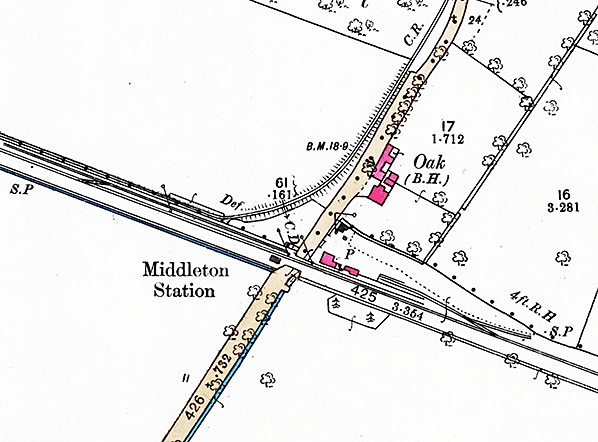
1885 1:2,500 OS map. By 1885 the station buildings at Middleton Towers were in place much as can be seen today. General goods was handled in a siding behind the platform. West of the road there was an exchange siding serving a tramway or light railway that ran alongside the Leziate Road to a quarry a few hundred metres to the north. The station was called Middleton at this time
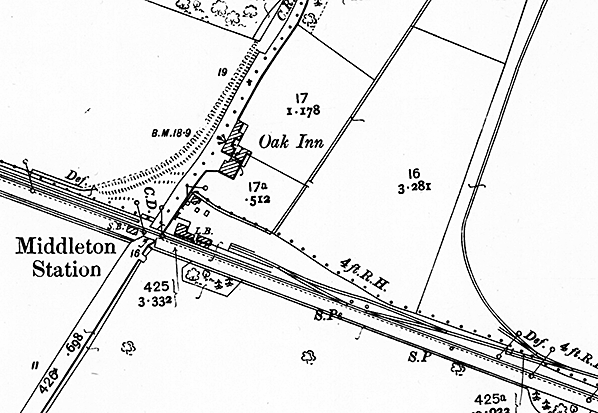
1905 1:2,500 OS map. When the map of Middleton Towers station was surveyed for the 1905 map the sand-pit to the north west had closed, the tramway was gone but its siding remained in place. East of the station work had started on new tracks to quarries opening to the north east. A signal box was provided immediately west of the crossing and signals are shown on the map. LB indicates the station had a post box.
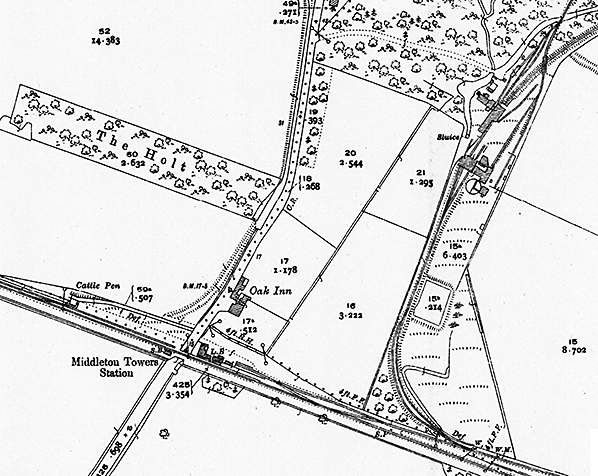 1928 1:2,500 OS map. The station was renamed Middleton Towers in 1924 but little changed since the 1885 depiction. However its surroundings were very different. To the west the siding, once used for exchange of sand cargoes, housed cattle pens. The 1904 RCH Handbook indicates that the station did not hand livestock. To the east the sidings had been extended and the quarry company’s 2 foot gauge and standard gauge lines served more distant sand-pits. Click here for a larger version.
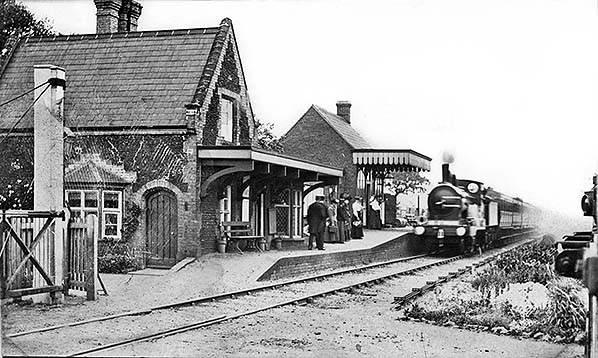
A Great Eastern Railway 2-4-0. probably an example of Class T19, is seen arriving at Middleton station with a train bound for Lynn, the year about 1905.
Copyright photo from John Alsop collection 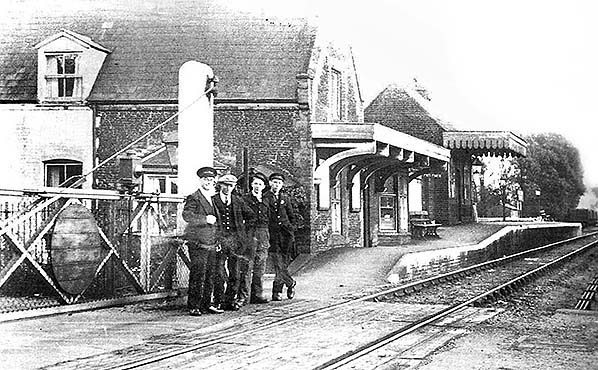
In October 1946 the station staff at Middleton Towers posed for the camera beside the crossing over the Leziate Road.
Photo from John Mann collection 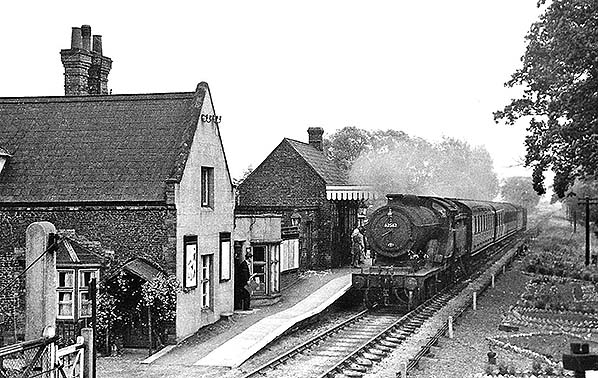
Seen in 1952, a D16 4-4-0 arrives at Middleton Towers with a Dereham to King’s Lynn stopping train. D16s were the mainstay power for this line’s passenger services until steam trains ceased in September 1955. At the station there was staff enough to maintain an attractive garden. 62562 was based at Norwich and King’s Lynn sheds at various dates in 1952. It was built in 1908 at Stratford Works and scrapped during November 1957, its final years spent at March shed.
Photo from John Mann collection  An undated photo, presumably taken from atop a signal post, looking through Middleton Towers station towards the west. The garden beside the crossing was maintained and there was a lower quadrant signal for up trains in the distance, suggesting a date only as late as the early 1950s. The solitary siding for general merchandise traffic was empty.
Photo from John Mann collection 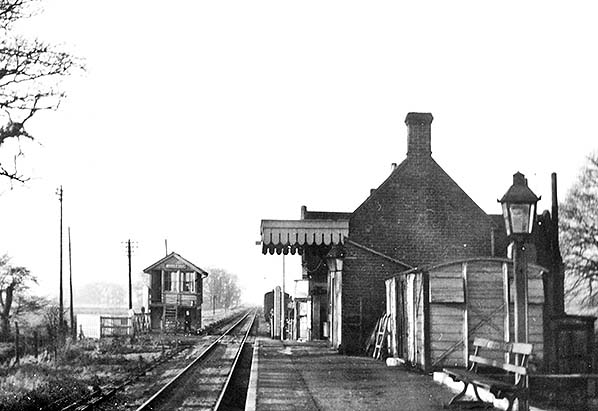
Middleton Towers station as seen on 22 December 1962. The garden on the left and the siding west of the crossing were still in place. A down train was signalled and the signalman is seen crossing the road, possibly with the single line token ready to exchange with the train’s driver.
Photo by G C Lewthwaite
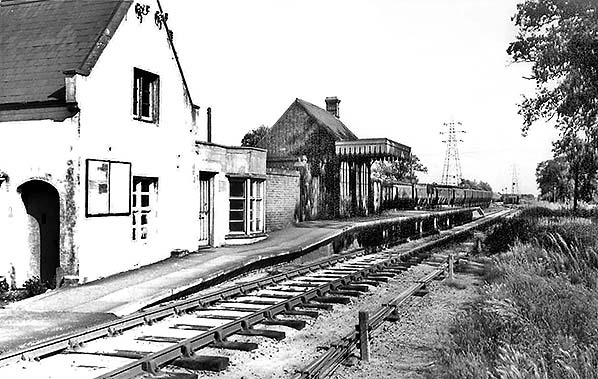
Middleton Towers station as it was just before passenger services ceased in September 1968. The main building had been completely rendered and the once tidy garden was overgrown. The sidings beyond the station had been altered to better accommodate the thriving sand traffic.
Photo from John Mann collection 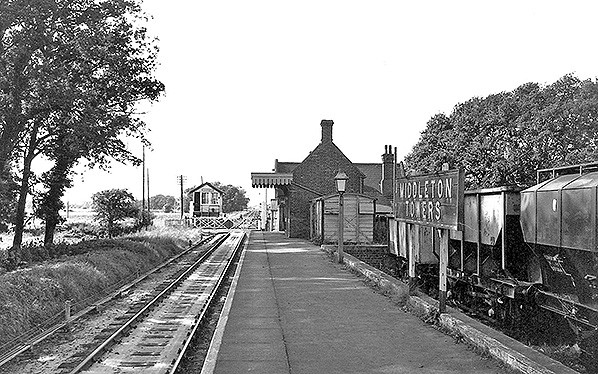 The view through Middleton Towers station towards the west and King’s Lynn just before passenger services were withdrawn in September 1968. The view through Middleton Towers station towards the west and King’s Lynn just before passenger services were withdrawn in September 1968.Photo from John Mann collection Click here for Middleton Towers Station Gallery 2:
|
 The station building is on the north (down) side of the single line beside a level crossing over the Middleton to Leziate lane. The station building, as originally built, was in an ornate style. A slate roof, its line at right-angles to the rails, covered a building of two contrasting shades, one of beige brick and the other of knapped local flint with a flat facet as its facing. The platform side boasted a canopy for shelter and a further three-face bay window. Above the canopy a window looked southwards from a first-floor room built into the roof. By the 1950s the canopy on the main station building was gone and the building rendered. An ornate chimney-stack topped it all off. A low platform for passengers was provided in front of the building: It is difficult to ascertain its original length because the platform was raised in 1882 and may have been extended. Part of the original platform was retained in front of the booking office door to avoid having to raise the door; there was a ramp up to the new level. On the higher platform a substantial waiting room, its roof-line parallel with the track, was built just east of the original building. The new provision included a canopy over the platform and heating. GER board board minutes only refer to a ladies' waiting room so it is assumed there was a general waiting room in the main building. Both the raised platform and waiting room were authorised on 21 February 1882 and completed a few weeks later. A 21 lever Stevens signal box was provided on the west side of the level crossing on the down side.
The station building is on the north (down) side of the single line beside a level crossing over the Middleton to Leziate lane. The station building, as originally built, was in an ornate style. A slate roof, its line at right-angles to the rails, covered a building of two contrasting shades, one of beige brick and the other of knapped local flint with a flat facet as its facing. The platform side boasted a canopy for shelter and a further three-face bay window. Above the canopy a window looked southwards from a first-floor room built into the roof. By the 1950s the canopy on the main station building was gone and the building rendered. An ornate chimney-stack topped it all off. A low platform for passengers was provided in front of the building: It is difficult to ascertain its original length because the platform was raised in 1882 and may have been extended. Part of the original platform was retained in front of the booking office door to avoid having to raise the door; there was a ramp up to the new level. On the higher platform a substantial waiting room, its roof-line parallel with the track, was built just east of the original building. The new provision included a canopy over the platform and heating. GER board board minutes only refer to a ladies' waiting room so it is assumed there was a general waiting room in the main building. Both the raised platform and waiting room were authorised on 21 February 1882 and completed a few weeks later. A 21 lever Stevens signal box was provided on the west side of the level crossing on the down side. 
 Middleton was one of five intermediate stations on the Lynn & Dereham that, soon after opening, had become request stops. The timetable for 1866, just twenty years into the line’s existence, offered only four trains in each direction, the first towards Lynn as late as 10.55am: passengers for Dereham found a 9.08am departure as their first option. The station was not an ’unstaffed halt’ but passengers wishing to travel had to arrive five minutes before the advertised time. Those wishing to leave the train had to inform the guard earlier in the journey. On Saturdays an extra train ran to Norwich for its market, leaving Middleton at 7.58am: returning market-goers caught the 5.20pm from Norwich and changed at Dereham. There was no equivalent help to reach the Lynn Tuesday Market.
Middleton was one of five intermediate stations on the Lynn & Dereham that, soon after opening, had become request stops. The timetable for 1866, just twenty years into the line’s existence, offered only four trains in each direction, the first towards Lynn as late as 10.55am: passengers for Dereham found a 9.08am departure as their first option. The station was not an ’unstaffed halt’ but passengers wishing to travel had to arrive five minutes before the advertised time. Those wishing to leave the train had to inform the guard earlier in the journey. On Saturdays an extra train ran to Norwich for its market, leaving Middleton at 7.58am: returning market-goers caught the 5.20pm from Norwich and changed at Dereham. There was no equivalent help to reach the Lynn Tuesday Market. 
 Steam passenger work ended with the British Railways Eastern Region summer timetable in
Steam passenger work ended with the British Railways Eastern Region summer timetable in 
 Home Page
Home Page